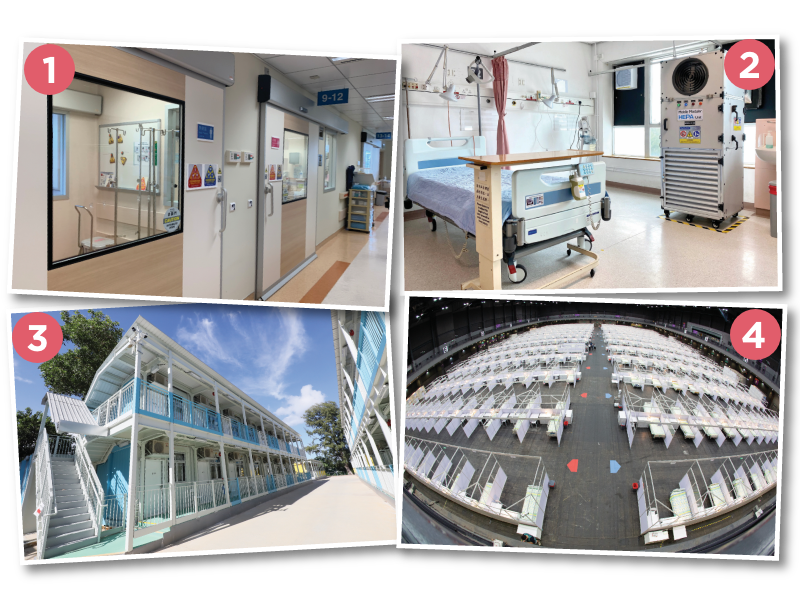Intelligence
Scalability of community facilities in containing the virus

The number of COVID-19 cases has been on the rise since the third wave of the outbreak hit the city in July, with emergence of infection clusters in elderly homes and restaurants etc. In response to the volatile development of the pandemic, a Community Isolation Facility (CIF) and a Community Treatment Facility (CTF) have been set up by the Hospital Authority (HA) to treat patients in the right place at the right time based upon a flexible approach with two factors: optimisation of care, and scalability.
The strategy was devised from the experience of SARS in 2003, explains HA Chief Executive Dr Tony Ko. “In 2003, one of the biggest challenges was that the insufficiency of isolation beds caused a higher risk of infection transmission. It illustrated the critical importance of isolation facilities in controlling an outbreak,” he says. “The global pandemic experience has also shown how exponential growth of infection can cause bottlenecks in isolation facilities in public hospitals within a short time. To prevent this, the HA began preparations in March to build up its capacity to tackle large-scale community infection through the early planning of facilities and a triage strategy.”
Under the triage system for isolation and treatment facilities, there are first-tier and second-tier isolation beds in public hospitals, CIF, CTF and a temporary hospital which is currently under construction. “Scalability is key – having flexible facility arrangements according to the development of the pandemic can optimise patient care,” Dr Ko explains. “In August and September, the CIF and the CTF were put on standby as the outbreak stabilised, allowing for the centralisation of resources and manpower. Also, the triage system ensures appropriate resource allocation and suitable treatment for different patients which eases the demand for isolation beds in public hospitals.”
The triage system is also designed to help the HA prepare for an increase in admissions during the winter service surge. “In winter, we anticipate a large number of patients may require admissions due to pneumonia, chronic obstructive pulmonary disease, and heart disease, which greatly stretches the capacity of Accident and Emergency Departments and medical wards,” Dr Ko says. “A tactful triage system for COVID-19 patients is therefore essential to reserve service capacity and minimise the impact on other medical needs.”
As the pandemic continues, the HA has accumulated invaluable experience from the enormous challenges to the healthcare system in areas such as infection control measures, resources and facilities allocation, and treatment protocol. Colleagues have demonstrated a consistently high standard of professionalism since the very beginning of the outbreak. “I would like to thank everyone for their selfless dedication,” says Dr Ko. “I am confident that, together, we will rise to this challenge.
The strategy was devised from the experience of SARS in 2003, explains HA Chief Executive Dr Tony Ko. “In 2003, one of the biggest challenges was that the insufficiency of isolation beds caused a higher risk of infection transmission. It illustrated the critical importance of isolation facilities in controlling an outbreak,” he says. “The global pandemic experience has also shown how exponential growth of infection can cause bottlenecks in isolation facilities in public hospitals within a short time. To prevent this, the HA began preparations in March to build up its capacity to tackle large-scale community infection through the early planning of facilities and a triage strategy.”
Under the triage system for isolation and treatment facilities, there are first-tier and second-tier isolation beds in public hospitals, CIF, CTF and a temporary hospital which is currently under construction. “Scalability is key – having flexible facility arrangements according to the development of the pandemic can optimise patient care,” Dr Ko explains. “In August and September, the CIF and the CTF were put on standby as the outbreak stabilised, allowing for the centralisation of resources and manpower. Also, the triage system ensures appropriate resource allocation and suitable treatment for different patients which eases the demand for isolation beds in public hospitals.”
The triage system is also designed to help the HA prepare for an increase in admissions during the winter service surge. “In winter, we anticipate a large number of patients may require admissions due to pneumonia, chronic obstructive pulmonary disease, and heart disease, which greatly stretches the capacity of Accident and Emergency Departments and medical wards,” Dr Ko says. “A tactful triage system for COVID-19 patients is therefore essential to reserve service capacity and minimise the impact on other medical needs.”
As the pandemic continues, the HA has accumulated invaluable experience from the enormous challenges to the healthcare system in areas such as infection control measures, resources and facilities allocation, and treatment protocol. Colleagues have demonstrated a consistently high standard of professionalism since the very beginning of the outbreak. “I would like to thank everyone for their selfless dedication,” says Dr Ko. “I am confident that, together, we will rise to this challenge.
Triage mechanism for isolation and treatment facilities
| Facility | Number of beds | Application |
|---|---|---|
| First-tier isolation bed | Around 1,200 | For patients admitted in severe condition |
| Second-tier isolation bed | Around 660 | For recovering patients waiting for negative test results |
| Community Treatment Facility | Hall 1 and Hall 2: Around 900 Other halls: 1,000 |
|
| Community Isolation Facility | More than 350 | For patients in stable clinical condition and waiting to be discharged |
| Temporary hospital | More than 800 | Equipped with negative pressure facilities to centralise patient treatment |